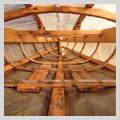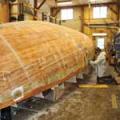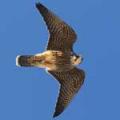Welcome Downeast
The Towns, the Bays, the Mountains
“Crocus buds push through thebarely thawed soil and who could imagine what they have in mind had we not the memory of former years? All our life we live in the barely thawed soil of an early spring, pushing up buds with glory in our minds,and none can tell what another may accomplish. For memory is all ofglory past, and glory yet to comeis another thing.”
—William Booth
Dear Friends:
One of the delights of March is more light. Not only that, but the sun is climbing higher in the sky every day, so those radiant sunbeams carry more warmth, bring the gospel of spring to the waiting plant and animal kingdoms, and stir our light-starved souls with new dreams and visions of seasons to come. What will I plant in the garden this year? When will we go to camp? Will we swim at the lake? When will we get out on the water? Will it be the summer of our dreams?
They say that if March comes in like a lion, it will go out like a lamb. And sometimes it does. But sometimes it comes in like a lion and goes out like a lion, and sometimes it comes in like a lamb and goes out like a lamb. This tells us less about the weather than it does about our human need to put things in some sort of order in an unpredictable world. So March returns again and our hearts are glad.
Natural events, March
Snow is pretty much gone along the coast and the weather seems more like April than March, with rain, drizzle, and fog being the order of the day. We all breathe a little easier knowing that the chances of two-foot snowfalls are slimmer every day. As the frost leaves the ground, roads heave into roller coasters and potholes appear from nowhere, just to make sure we don’t fall asleep at the wheel.
Field and forest report
Flocks of goldfinches, purple finches, chickadees, song sparrows, and fox sparrows mob the bird feeders all day long, while robins and mourning doves stalk around on the ground. Flocks of redwings, starlings, and grackles gather in the trees. They say birds of a feather flock together, but so do birds of different feathers at this season, until they begin to pair up for courting and nesting.
Toward evening, the white-tailed deer come for a snack and a drink from the bird bath. They look much more healthy and well-fed than they did last March when the light was nearly gone from their eyes and you could count each rib. Maple trees are giving up their bounty of sweetness as smoke rises from the sugar shack.
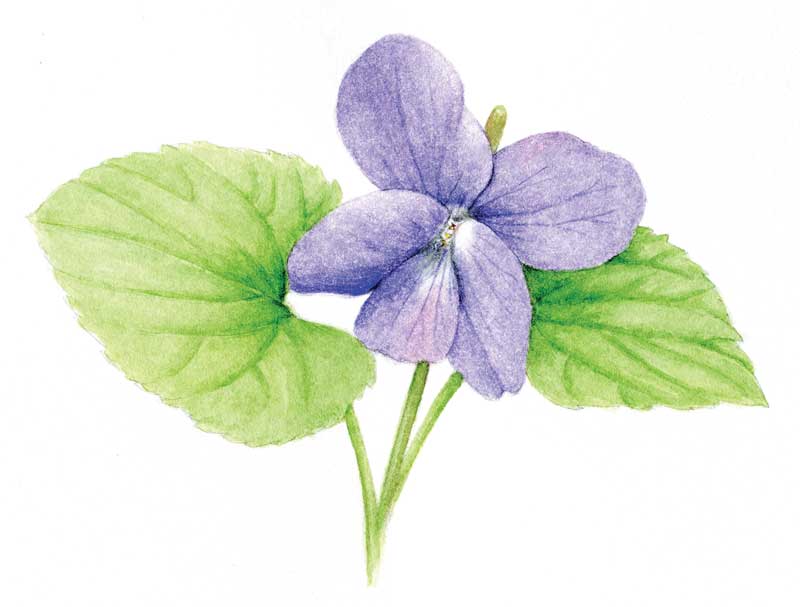 Illustration by Candice Hutchison
Natural events, April
Illustration by Candice Hutchison
Natural events, April
In New England they like to say that things are better once we get over “March Hill.” Well, we are now over March Hill, but in Maine, it has to be said, April often looks a lot like March. So if you have not yet had enough of frosty nights, chilly mornings, the gray and brown landscape, and hauling firewood, fear not, there are still more to come. The nice thing about April, though, is that all of those things are on their way out, exiting stage left, as it were, and hopefully in a timely fashion.
And all the joys of spring and summer are waiting to make their entrance stage right—if you are facing north, that is. The exquisite beauty of spring in Maine is its long teasing, showing a hint of splendor and then hiding it again, bathing us in warm sun, then chasing it away with a late flurry of snow. April is a month for mindfulness, for paying attention, because the changes come slowly, so slowly, staying longer every day. There is still frost in the ground, but by the end of the month the grass will be green and the first wildflowers will be in bloom: bluets and violets in the meadows and colt’s foot in the ditches.
Real things take time. Watch and wait, watch and wait patiently. She is shy, spring. But she surely comes, closer and closer.
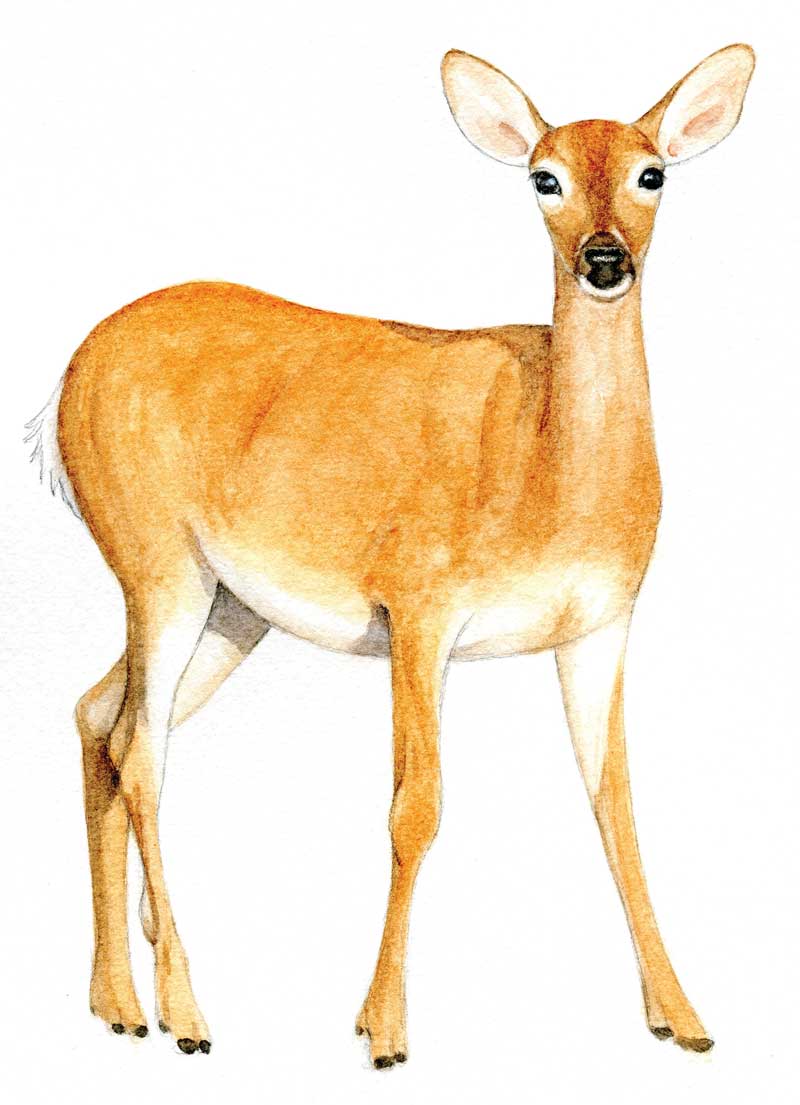 Illustration by Candice Hutchison
Field and forest report
Illustration by Candice Hutchison
Field and forest report
We watch the deer all year, but no more than they watch us. Sometimes we’ll go outside thinking of something else entirely and then feel their eyes upon us from the field above the bay. We’ll look up to find their huge eyes on us—missing nothing, their elegant ears taking in every sound we make from a hundred yards away, and their delicate noses sensing the smells of wood smoke and coffee that we carry on us. These days they are shedding their winter coats and changing their diet from browse to pasture. You can see the difference in their droppings. Now and then they will start jumping and hopping and chasing each other for no reason, just pure exuberance that winter is over. Now and then we’ll do that, too.
Sharp-pointed shoots of green valiantly pierce the frosty soil: crocuses, daffodils, irises, daylilies, and others of the species Allium are proving that a Maine winter cannot kill them. These bulbs are remarkable parcels of indomitable life. Buried in the dark frozen ground and with no eyes to see, still they know their time for rising. What a generative power! What a tenacious hold on life! It’s no wonder that another Allium, the Easter lily, is the ancient symbol of resurrection.
“Mud time”
We’re into that part of Spring that New Englanders call “mud time,” when the deep frost comes up out of the ground, meets the April showers that come down, and turns the earth into a huge pudding of sorts that clings to everything: your boots, the dog’s feet, the kitchen floor, and the living room rug, if you get that far with your boots on. If the day is warm you may want to work in the garden, but find that you are tracking too much of it back into the house come lunch time. If the next couple of days look nice you may decide to drive out to camp, only to sink up to your wheel-hubs once you get off the paved road. At such a time, four-wheel drive may not help all that much because it can tempt you to go where you shouldn’t.
That’s the bad news of mud time, but the good news is that there may be two or three weeks or more when you can work outside and get early-season chores done before the blackflies begin to hatch and bite. And there is no sweeter sensation than to sit on a stump or stoop with mud caked on your boots and warm sun shining on your face, whispering that a new world is coming, the world that ended back in the fall. The sun heralds the return of the season when you can smell the mud again, when you can hear the love songs of the little singing ones, when you can taste fresh greens, when you can see life exuberantly living itself again.
Natural events, late April
The earth shows us once again what we knew all along, but very nearly forgot: that she will not die, despite the blowing snows, the bitter wind, the many deaths, and the long darkness.
Crocuses bloom in warm, sheltered places and the grass greens up on southern slopes. Brooks and streams rush with the earth-scented, tawny waters of run-off. Dogs and cats stretch and stay out longer when let out in the morning, and rest on the sunny side of the house outside in the afternoon. Blackbirds add their chirping chants to those of mourning doves, cardinals, and blue jays. Sunlight pours in windows. Even houseplants perk up and start to put out new buds and blooms.
As without, so within. The gut feeling of spring is in us, visceral and real. Like sap in maples, our blood rises. Like flights of birds, our pulse quickens. Like the breast of the earth, our hearts warm and swell. Like the whole land, we are brought back to life, and Hoo Boy! It’s great!
We watch with wondering eyes as plants pump sap into their buds, buds expand, bud scales open and fall away, and soft green tissue shyly appears. From the flea-size buds on spirea to the thumb-size buds on horse chestnut, all around us, new leaves are taking shape before our eyes. We ask ourselves how these tiny parcels of undifferentiated green stuff know what shape to take, what to become, what job to do, what course to follow. Where is the design they will inevitably fulfill? Is it written in their cells? Is it stored in the root of the plant, the heart of the earth, or the mind of the Creator? What immortal hand or eye could frame this cheerful symmetry?
Field and forest report
Red maple (Acer rubrum) is in bloom and the long, tawny catkins of quaking aspen (Populus tremuloides) are soaking up the sun and pollinating each other even before the leaves come out. Aspens, or “poplars” as they are more often called in Maine, have male and female trees, and both display their fuzzy catkins or flowers these days. Aspen is one of the softest of hardwoods and is good for cabinetry and carving, but not so good for firewood. Beavers favor aspen bark for food and have developed a form of silviculture to grow more of it. They find a stream with aspen nearby and cut down the trees to dam the flow and create a pond. The pond drowns out other trees. After they have consumed all the aspen within walking distance of their pond—and they don’t like to walk far—the beavers move out, the dam collapses, and the pond drains, leaving a meadow. The aspens move back in again, and when they reach the right size, another generation of beavers returns for the harvest and repeats the cycle. And we thought we invented farming.
Seedpod to carry around with you
From Margaret Atwood: “In the spring, at the end of the day, you should smell like dirt.”
That’s the Almanack for this time. But don’t take it from us—we’re no experts. Go out and see for yourself.
Yr. mst. humble & obd’nt servant,
Rob McCall
Rob McCall lives way downeast on Moose Island. This almanack is excerpted from his weekly radio show, which can be heard on WERU FM (89.9 in Blue Hill, 99.9 in Bangor) and streamed live via www.weru.org. Reach Rob via email at awanadjoalmanack@gmail.com.
Related Articles
Share this article:
2023 Maine Boat & Home Show

Join Us for the Maine Boat & Home Show!
Art, Artisans, Food, Fun & Boats, Boats, Boats
August 11 - 13, 2023 | On the waterfront, Rockland, Maine
Click here to pre-order your tickets.
Show is produced by Maine Boats, Homes & Harbors magazine.







